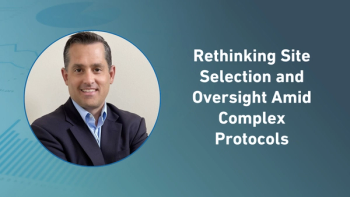
- Applied Clinical Trials-05-01-2004
A Perspective from One Clinical Research Center in the United Kingdom
Trepidation and concern have been central to many U.K.-based discussions on the impact of the EU Directive on Good Clinical Practice in Clinical Trials.1 Some have suggested that the constraints imposed by the impending legislation may stifle innovation, leading to a reduction in novel academic research and the closure of some research centers. Other academic institutions are worried over increased costs of registering for any research project and of training the staff in good clinical practice (GCP). Many are also awakening to the implication of having one registered sponsor for each study who carries an exceedingly heavy administrative and legal burden.
Trepidation and concern have been central to many U.K.-based discussions on the impact of the EU Directive on Good Clinical Practice in Clinical Trials.1 Some have suggested that the constraints imposed by the impending legislation may stifle innovation, leading to a reduction in novel academic research and the closure of some research centers. Other academic institutions are worried over increased costs of registering for any research project and of training the staff in good clinical practice (GCP). Many are also awakening to the implication of having one registered sponsor for each study who carries an exceedingly heavy administrative and legal burden.
Admittedly, there are very big changes in store for the processes and cost of academic research and the good laboratory practice that must accompany it. Established research centers whose primary aim has been to promote good research with patient safety as their primary objective, however, have nothing to fear. The rigor of procedures and regulation has been with us for a long time. All that has changed in reality for an investigative unit such as ours is that our voluntary code of practice based on ICH, GCP 19962 is now mandatory, and subject to the disciplines which any enforcement brings.
As a dedicated clinical research unit for clinical trials and academic studies within a large London teaching hospital, we have been awash with in-house circulars, bulletins and documents, external journal articles, various training sessions, and meetings on how the directive will be making considerable changes to our working practices. There is a reminder from a symposium at the Medical Sciences Academy Forum (2003)3 that the directive will have a "profound effect upon us all." More recently still, The Institute of Clinical Research reported the concerns many researchers still had about the impact of the directive and how their processes might need to be radically changed.4 There is even a growing call for the EU Directive to be repealed.5 We are all unprepared. We need to be trained in the ICH Code, and trained as a matter of urgency!
The code of practice was developed within the Expert Working Group of the International Conference on Harmonisation of Technical Requirements for Registration of Pharmaceuticals for Human Use (ICH), and the final draft was recommended for adoption to the regulatory bodies of the United States, Japan, and the European Union in April 1996. GCP is an international ethical and scientific quality standard for the designing, conducting, recording, and reporting of trials that involve human participation. Compliance with this standard provides public reassurance that human subjects in clinical trials will be protected and have their rights acknowledged and observed. Adopting the guideline also confirms some mutual agreement of any clinical data generated from a study by the regulatory bodies of those participating countries, thus strengthening any marketing application.
Table 1. The 13 principles of ICH, GCP
Essence of the directive
The EU Directive now seeks essentially to legalize all the principles of ICH, GCP for two distinct reasons. First, the protection of its citizens is of paramount importance. Second, there is a commercial intention within the directive to make Europe more competitive in the clinical trials industry. It is anticipated that this will be achieved by the harmonization of the clinical trials process and the standardization of regulatory body approval.
This cannot come soon enough. Member states and indeed the United States have come under increasing competition from Eastern European countries such as Poland and Estonia, with their rapid regulatory submissions and speedy recruitment rates. Nevertheless, this drive to enhance clinical trials delivery has taken a long time.
The directive has at last come to fruition after 11 years of drafts, draft changes, a concept paper produced in 1995, and a draft directive in May 1996. It was approved by the European Parliament in December 2000 and published in the Official Journal of European Communities in May 2001. After publication, there is a period of three years to implementation (two years for member states to publish the appropriate legislation and one year to enact it). There are also numerous guidance notes prepared in consultation with the member states. To date, five of these have been finalized, and they include guidance documents for ethics committees (2003)6; competent authorities (2003)7; collection, verification, and presentation of Adverse Events (2003)8; database on Suspected Unexpected Serious Adverse Reactions (SUSAR) (2003)9; and European Clinical Trials Database (EUDRACT) (2003).10 Still to be finalized at press time were the final version of the Good Clinical Practices,11 Trial Master File and Archiving,12 Inspection procedures,13 and Inspector qualifications.14 These will be written as two directives, which will automatically become law in all member states.
The scope (Article 1) of the directive includes all clinical trials using medicinal products but does not apply to noninterventional trials and expands considerably upon the ICH, GCP (1996) guidelines. Their headings are listed in Table 1.
Consider then the articles 3-5 of the directive: Protection of Clinical Trial Subjects, Trials on Minors, Consent in Incapacitated Adults, and the general emphasis and similarity to the ICH, GCP guidelines become clear-patient safety is paramount. When we conduct research we must respect the privacy, rights, and well-being of participants. This may seem a straightforward, almost automatic process, but it is so easy to forget the dignity and safety of research subjects. How often, for example, are obese subjects weighed in the corridor in full view of everybody, or inappropriate rooms used for physical examinations? Can we really be sure that subjects do understand the implications of the study before they give their consent? How often are unnecessary tests performed on these subjects?
Table 2. List of headings for the 24 articles in the EU Directive
Although both the directive and ICH, GCP guidelines cannot truly measure this kind of patient dignity and rights, it is appropriate enough that the powers that be are allowed to audit any study for compliance around these issues. New regulations make unnecessary testing and repetitive studies obsolete because they will need appropriate peer review. It will become impossible to conduct studies upon those incapacitated adults who cannot give consent freely unless the study has already been conducted with subjects who can freely give consent. All studies will also need to be registered with the EU database before commencement.
Our clinical research center will also be exploring our own practices and measuring service provision. Giving the research subject a voice improves the service for centers such as ours and assists us in the identification of our shortcomings. Perhaps the directive should include some mechanism for subject feedback. Auditors will also surely look favorably upon those centers that seek to gain insight into their practices by way of customer surveys.
Pediatric trial implications
There is also another implication for our service expansion within the directive. Centers such as ours must therefore prepare for an increase in pediatric studies and ensure that the environment of the center, staff training, and clinical trial delivery is appropriate and sympathetic to the needs of children. In the past, pediatric clinical trials were by and large frowned upon because testing new drugs on children was thought unethical. This has led to a large number of untested drugs being used in many situations, which is also undesirable. The directive acknowledges this and has approved theory, which allows medicinal products to be tested if they are likely to be of significant clinical value for children.
Although other articles also reflect the emphasis on patient safety through the data protection act and the reporting of Adverse Events, the remainder of the directive is concerned with the harmonization of the clinical trials process. In the United Kingdom, concerns exist over the increased organization of conducting a clinical trial.
For example, Articles 6-9 outline the responsibility of the ethics committee and the quality of the application, and gives time frames for committees to respond to applicants. Again, although there may be some organizational issues on how committees will be able to respond within the allotted time, the procedures for ethics submissions and the conduct of regulatory bodies has already been in working practice for a very long time in the United Kingdom, as defined by the Research Governance Framework for Health and Social Care.15 Apart from some agreed time frames for response, which is most welcome, there is nothing to panic the researcher in the directive. Even the ethics application has been recently standardized in the United Kingdom so that the same form will be used for both multiple and local submissions.
Indeed, this directive is based upon the implicit assumption that many of the processes that involve clinical trials will be standardized, and the information shared on a common database. This standardization does not, however, translate well in the real world, and it is here that hospital research centers will need to act.
Research and Development Directorates, through which all research passes, must standardize their processes if the ethos behind the directive is to be upheld. It is here that common registrations of research projects, data protection forms, applications for indemnity, and the rules surrounding peer review would benefit from the same operating procedures across the board. Although some collaboration exists between sister hospitals, the directive would have done justice to most researchers if it insisted upon the uniform method of how new projects are presented to all R&D offices together with a time frame for when the researcher may get a response. Again, the Research Governance Framework gives guidance on R&D responsibility, but falls short of operationalizing the exact mechanism.
In the United Kingdom, the amount of time that Lead Investigators may be allocated for research by way of the new Consultant Contract may be limited. A standardized pack of documents required by the R&D department and regulatory bodies will hopefully assist the beleaguered researcher through the clinical trials maze and may lead to an increase in business. Training of research center staff in the future will therefore include not only Good Clinical Practice, but also practical information on regulatory requirements and the exact documentation needed. It therefore makes good sense for our research center to further our own standard operating procedures by including this information and act as an additional advisory service to would-be researchers.
Addressing academic concerns
We have acknowledged that it is the academic researcher who is hit the hardest by the directive. Vallance, in his recent article,
16
establishes a real cause for concern among those conducting small clinical trials-especially pilot studies for funding application, mechanistic studies, and projects using existing drugs in clinical practice-that increased costs and bureaucracy will mean fewer projects being undertaken. Again, there is a certain amount of unwarranted fear. Concerns regarding what studies are and are not covered by the directive can be ascertained and clarified by the Medicines and Healthcare Products Regulatory Products. However, what is most certain is that the cost of noncommercial studies will increase substantially, and that for these types of studies to continue there will be a need to resource new research structures, train staff, and put in place the kind of standardized procedures just mentioned.
The directive also requires the researcher to undertake a number of responsibilities when conducting a research study. Such responsibility is nothing new for clinical trials sponsored by the pharmaceutical community, but few in academic circles are willing to undertake the onerous task of being sponsor for their research project. Such tasks include ensuring the validity of the proposed project, undertaking all regulatory requirements, training the staff involved in the project, ensuring that there is sufficient resource to produce high-quality accurate data, and producing written agreement on responsibilities among the research group. There is also the provision of compensation, arrangements for disseminating the findings, and the dignity and safety of subjects to be upheld at all times.
The lack of clear operational procedure for academics conducting their busy clinical workload and the onerous responsibilities they may face have implications for research centers such as ours. The center itself can become the "sponsor" for the project, ensuring all regulatory requirements, training, and resources are in place. It will be able to do this because most of the requirements are already there. But the service will come at a price, as we will need to increase our experienced research staff to meet the demand.
The rate of enquiries to the research center from academics keen on undertaking new projects or wanting a "safe" venue for their existing study has already commenced and grown from an inconsistent drip to a steady trickle. There will be some fall-out among projects, but that may be good, for only the more robust will remain and attract the many funding opportunities which still exist. More researchers than ever are now aware of our center and what it can provide. It may not suit all projects, but our venue and the services we provide are being considered as never before.
Researchers are also talking more to each other and listening to the voice of the R&D department. Research workshops have been organized, and for the first time ever the idea of a research strategy among directorates has been entertained, debated, and reported upon. The message from research strategy workshops organized by our R&D has been simple-we need to plan our research ahead to stay competitive.
The general consensus of opinion may have been that the academic world failed to engage the European Union and its commissioners in the development of the EU Directive. At last it has woken up to the implication and decided to begin to work together with agencies such as the MHRA to form a coherent force, which will embrace the long research road ahead. For our unit, this is an exciting time to gain new business and be part of that cohesive force. To us, the directive is not saying anything new, and our established compliance puts us in a better position than ever before for undertaking the role of sponsor for academic studies. It provides a legal framework by which our unit may have input into the organization, planning, management, control, and accountability for an increased number of studies. We will develop our expertise to accommodate this anticipated request for our services.
EU Directive in Clinical Trials-bring it on!
References
1. Directive 2001/20/EC of the European Parliament and the Council of 4 April 2001 on the approximation of the laws, regulations and administrative provisions of the Member States relating to the implementation of good clinical practice in the conduct of clinical trials on medicinal products for human use. Official Journal of the European Communities, L121, 34-44 (1.5.2001).
2. ICH GCP official Web site contains all official documentation and is located at
3. European Clinical Trials Directive. A summary of papers presented at the Symposium organized by the Academy Forum on 3 June 2003, London. The Academy of Medical Sciences/Forum.
4. A. Smith, (ed) "Repeal the EU Directive? Too Late," Clinical Research Focus, 15 (1) 4 (February 2004).
5. The campaign to repeal Directive 2001/20/EC, located at
6. EC Detailed guidance on the application format and documentation for application to Ethics Committees. Final April 2003, located at
7. EC Detailed guidance for the request authorisation of a clinical trial to competent authorities. Final April 2003, located at
8. EC Detailed Guidance on the collection, verification and presentation of adverse reaction reports arising from clinical trials. Final 2003, located at
9. EC Detailed guidance on the European database of suspected unexpected serious adverse reactions (Eudravigilance) Final April 2003, located at
10. EC Detailed guidance on the European Union Clinical Trials Database (EUDRACT) database. Final April 2003, located at
11. EC Detailed guidance on the principles of good clinical practice. Draft Version 5.1 July 2002, located at
12. EC Detailed guidance on trial master file and archiving. Draft. September 2002, located at
13. EC Detailed guidance on Inspection procedures for GCP compliance. No version, located at
14. EC Detailed guidance on qualification of Inspectors. No version, located at
15. Department of Health (2003) Research Governance Framework for Health and Social Care. DoH London UK. Located at
16. P. Vallance, "View from the Top: Small, Innovative Clinical Trials Are Under Threat," Research Fortnight, 14 (May 2003).
Articles in this issue
over 21 years ago
eShowcaseover 21 years ago
Anticipating New Regulatory Hurdlesover 21 years ago
The EU Directive: Practical Implications for Clinical Research Teamsover 21 years ago
FDA Seeks New Strategies to Improve Clinical Researchover 21 years ago
What Price Better Health? Hazards of the Research Imperativeover 21 years ago
Letters to the Editorover 21 years ago
Europe?s View of World Gaps in GCPNewsletter
Stay current in clinical research with Applied Clinical Trials, providing expert insights, regulatory updates, and practical strategies for successful clinical trial design and execution.






.png)



.png)



.png)
.png)
